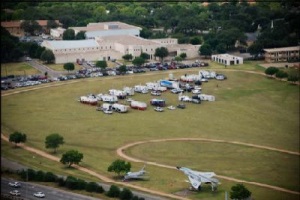Camp Mabry Prepares For Next Hurricane With DICE
Elizabeth Cohen, Texas Military Forces Public Affairs
2009/06/08
 Camp Mabry’s parade ground was transformed into a state-of- the art mobile communications park during the DICE exercise being conducted here June 1-4, 2009.Photo by Staff Sgt. Eric Wilson, Texas Military Forces Public Affairs
Camp Mabry’s parade ground was transformed into a state-of- the art mobile communications park during the DICE exercise being conducted here June 1-4, 2009.Photo by Staff Sgt. Eric Wilson, Texas Military Forces Public Affairs
Camp Mabry, Austin, Texas (June 8, 2009) – The Department of Defense Interoperability Communications Exercise, or DICE, was a four-day long event at Camp Mabry. This exercise included over 25 agencies participating on state, local and national levels, many of whom where communication experts who sought to test emergency communication through a simulation of hurricane conditions.
Situated on Camp Mabry’s parade field was a double line of vans, representing the first responders in the event of a natural disaster. Towards the center sat Sprint/Nextel’s Satellite Cell on Light Truck or SatCOLT, a vehicle designed to give a satellite-powered version of cell phone service to the hundred wireless handsets that Sprint had brought and charged for DICE. These were used in the exercise to simulate downed cell phone towers and snapped power lines.
“We are here to support the other units,” said Lee Martin, Raytheon Director of DoD Sales. He and his team ensured that the radio systems of the first responders were tied together, so they could talk to one another. “Everyone has their own system,” Martin added. “[but they] all have to talk on a common network.” Raytheon gear provided this synergy.
“This is what tax dollars get you,” said Cary Snyder, Technical Support Manager of Sprint’s Emergency Response Team, as he indicated the emergency response vans around his SatCOLT.
The inside of the vans were equipped with all the technology that each specific agency would need to complete their part in a natural disaster setting. Some, such as the Texas General Land Office, were visiting with communications consultants about upgrading their technology. “We are here to learn,” said Greg Pollock, Deputy Commissioner of Oil Spill Prevention and Response of the TGLO. He and his team were there to observe, and thus were not actively scripted into the exercise, Pollock added.
Chief Jack Colley, Division of Emergency Management, Office of the Governor, arrived on the final day of the exercise to discuss the objectives of DICE. “This exercise is extremely important because it shows the efforts of about eight years of not only funding but deployment of equipment across the state and our capability to work together as a team throughout the entire state of Texas. Our focus is on a single effort which is to provide a rapid and orderly response to any event,” Colley said.
Chief Colley was briefed on the event by Col. Kevin Turnbo, J6/Chief Information Officer. According to Col Turnbo, the DICE program consists of five phases: check-in, staging, training, and the breakdown and after-action report. Col Turnbo said that: “The after-action reports resulting from this training should prove invaluable to operators during the coming hurricane season.” The DICE exercise shows that many state, local and national organizations and first responders to disaster situations are gearing themselves up for the hurricane season.